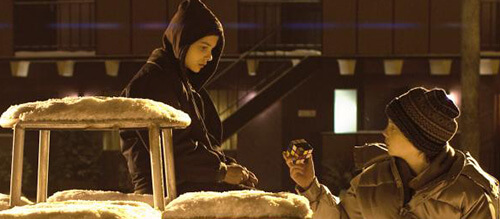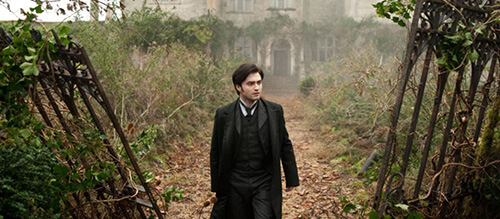Holy Water and Unholy Ghosts – The Resurrection of Hammer
This article was contributed to The Film Magazine by Kieran Judge of HorrorAddicts.net and Horror Reviews by the Collective.
Ten years ago, on an almost forgotten site called MySpace, something happened. A web series was uploaded, comprising of a handful of twenty four minute episodes which, when combined, formed a feature-length film. Beyond the Rave presented a young man attending a rave in the country whilst trying to reconcile with his girlfriend. Unbeknownst to those attending, the rave is a trap by vampires to harvest their blood.
The story isn’t exactly fresh or new, and nothing in the series is incredibly gripping or frightening, mostly due to the episode length not allowing for significant suspense to be generated. What was interesting, however, was the name of the company who made it.
Hammer.
This was the first video production for decades from the legendary studio that had brought Christopher Lee and Peter Cushing into the spotlight in Technicolor castles of bright red blood. The British institution behind reviving Dracula, The Mummy, Frankenstein, and dozens of others from the black and white dust of Universal, had been purchased the year before by Simon Oakes and Marc Schipper. They weren’t going to treat Hammer as an antique. Oh no. They found the most experimental medium, on the most modern platform, wrote a contemporary story, threw a load of blood at the screen, and put it up for the world to see.
This wasn’t just a web series. This wasn’t just a publicity stunt. This wasn’t an attempt to recapture a horror fan’s nostalgia. This was a bold statement that said: ‘We’re back, and we’ve evolved’.
Not wasting any time, Hammer plucked up Cloverfield’s director Matt Reeves and kept to their vampiric roots, grabbing the rights to re-adapt John Ajvide Lindqvist’s Let the Right One In, (which had been adapted once in Lindqvist’s native Sweden already in 2008). Let Me In shifted the suburbs of Stockholm to Los Alamos, New Mexico, and traded Oskar and Eli for Owen and Abby. Performances by Kodi Smit-Mcphee and Chloë Grace-Moretz were highly praised, and whilst the film was incredibly unsuccessful at the box office (just about surpassing its production budget), critical opinions were generally high.
It seemed that Hammer had started to get the ball rolling. Quickly following up in 2011 was The Resident, a psychological thriller set in New York of Hilary Swank being stalked by Jeffery Dean Morgan. The film isn’t incredibly new, and if you’ve seen Sleeping with the Enemy or Fatal Attraction, or even Psycho, then you’re going to recognise similar beats. It also features Sir Christopher Lee in his last role for Hammer, the studio that had given him so much, and the first since To the Devil a Daughter in 1976.
The same year saw Hammer release Wake Wood, a full-on pagan horror film reminiscent of classic British 70’s films like The Wicker Man and Blood on Satan’s Claw, with a little Pet Semetary thrown in for good measure. It’s a tale of grief and heartbreak, and an underappreciated performance by Timothy Spall makes it a memorable film of emotion and empathy, rather than straight-up terror. A family wanting to do anything to see their child beyond the veil of death is about as human a story as you get. It’s not perfect, but it’s a little gem of a film.
Hammer, in four films, had managed to snag some of the biggest stars in film, including those on the rise, and managed to produce films that had good budgets and production values, and were all contemporary with no cobwebs in sight. One final push would set them up for a full on, full-scale revival.
They found it in 2012 with The Woman in Black.
Adapted from the Susan Hill novel of the same name, Hammer returned to its gothic roots and put global superstar Daniel Radcliffe in the lead, the first film since the Harry Potter series. The beautiful visuals, chilling scares, great performances and commercial drawing-power of their star, meant that The Woman in Black was a massive success. Ciaran Hinds’ chemistry with Radcliffe (probably helped by their work on Harry Potter and the Deathly Hallows: Part 2), helped boost the film’s earnings to roughly $127m worldwide, from a $17m budget.
Hammer had the horror world by the throat. They were back.
Were.
In 2014 they released The Quiet Ones. I don’t know what happened. Possibly inspired by films such as The Conjuring, Insidious and The Last Exorcist, it follows an Oxford experiment to rid a young woman of her mental illness, which inevitably turns out to be supernatural. This is a film which obviously seemed like a great idea at the time, keeping in the paranormal, gothic roots of The Woman in Black, but with fresh twists such as the inclusion of found-footage sections built into the narrative.
The problem is that the characters are flat, cardboard cut-outs, the tension switched for cheap jump-scares, and the threat never truly threatening. Combined with a final scene to forget, the film failed to make even $18m, not even a tenth of The Woman in Black’s intake. It was only made (reportedly) for $200K, but that isn’t the problem. It’s a profit, but people knew this was an inferior film. And what could have been the perfect way for Hammer to capitalise on their success and spiral upward into new heights, became a film very few remember.
Hammer’s most recent film was a sequel to The Woman in Black in 2015, The Woman in Black: Angel of Death. This wasn’t a surprise that a sequel would be made so quickly. And whilst the mist-drenched forests surrounding Eel Marsh house are cinematographically exquisite, there’s something missing. The genuine grief that embodied Jennet Humphreys in the first film is replaced by a shallow, stereotypical malevolence, a shadow of her former self. Whereas the first film felt personal, this one is a perfect example of a studio trying to up the stakes without consideration for the craft of storytelling. The final plot twist about summed it up, if it could be considered surprising enough to be a twist. There’s just no emotion in the film. It feels hollow.
The film made a tenth of its predecessor’s box office takings, and critical reception was overwhelmingly negative. Hammer needed to take a break, figure out what had gone wrong since 2012, and come back fresh.
The studio has since branched out into other mediums. “The Soulless Ones”, an interactive stage play, opened a year ago, and Hammer partnered with Titan Comics at roughly the same time to begin producing comic adaptations beginning with “The Mummy”. Mark Gattis also adapted an unproduced script for Radio 4 called “The Unquenchable Thirst of Dracula”. Oakes, it seems, is trying different avenues into securing the company as a firmly established, current player in all things horror, and not simply a company playing with a movie camera again.
A year ago, Hammer announced they were putting The Lodge into production, a new film with Veronika Franz and Severin Fiala, directors of Goodnight Mommy, at the helm. Though I’ve heard no news since, one can only hope it is done well, with the intention of good filmmaking, rather than cashing in on things that have come before. Due to the silence for nearly a year (as far as I’m aware), I can only hope that the company has sat their team down for the project and told them to take their time, make sure everything is done correctly and properly, to plan, to think it through.
The legendary studio is still in there somewhere, deep down, though currently it feels much like a vampire at a novel’s beginning; making an appearance every chapter or two, but not enough to be named one of the undead by the village folk. One can only hope, for the sake of the horror industry (and film industry as a whole), that Hammer will come back fighting, and along with companies such as Blumhouse and A24, remind the major Hollywood studios that proper horror simply relies on getting everything right, and not just budget. To paraphrase Mark Kermode, horror is the one genre where the independent filmmakers have as much chance of being noticed as the big studios. Hammer has the chance to straddle that line and take the best of both worlds, independent love of filmmaking and decent financial input.
I sincerely hope they come back properly again. I don’t want to have to bury Hammer Horror for a second time, because then it might be for good.
Be sure to support the other platforms Kieran contributes to, at:
HorrorAddicts.net
Horror Reviews by the Collective



